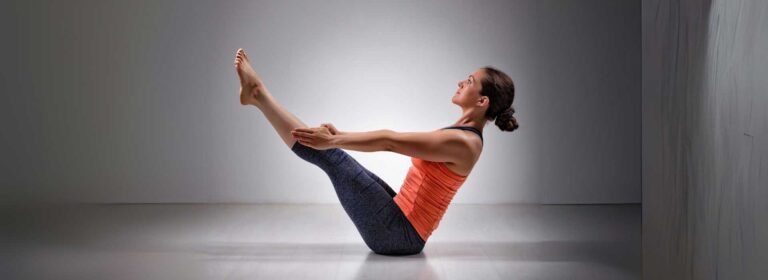Yoga Practice Name
Navasana (नावासन)


Navasana (नावासन)
Boat Pose
Navasana is a core-strengthening yoga posture that resembles the shape of a boat. The pose engages the abdominal muscles, hip flexors, spine, and legs, promoting balance, focus, and stability. It is commonly practiced in both Hatha and modern yoga styles for building core strength, improving posture, and stimulating digestion.
1. Starting Position – Dandasana (Staff Pose): Sit on the floor with your legs extended forward, spine erect, and hands resting beside the hips.
2. Bend the Knees Slightly: Bend both knees and place your feet flat on the ground, keeping the spine straight.
3. Lean Back Slightly: Engage your core and gently lean back, keeping the spine long and chest lifted. Avoid rounding the back.
4. Lift the Feet Off the Floor: Slowly lift your feet off the ground, bringing the shins parallel to the floor so the legs form a tabletop position.
5. Extend the Arms Forward: Stretch your arms forward, parallel to the ground, palms facing each other. Keep your shoulders relaxed.
6. Straighten the Legs (Optional for Full Pose): If you are comfortable, gradually straighten your legs, forming a "V" shape with your body. The torso and legs should be at about a 45-degree angle.
7. Hold the Pose: Maintain balance on your sitting bones, engage your core muscles, and keep breathing deeply and steadily.
Hold the pose for 15–30 seconds (or longer with practice).
8. Release the Pose: Slowly lower the legs and torso back to the floor. Rest in Savasana or seated posture.
1. Ardha Navasana, 2.Ubhaya Padangusthasana, 3.Paripurna Navasana, 4.Tolasana, 5.Utkatasana, 6.Chaturanga Dandasana
1. Core is the Center of Power – The abdomen is the main area of engagement. Activating the core muscles ensures stability, balance, and proper posture throughout the pose.
2. Balance on Sitting Bones (Ischial Tuberosities) – The body should balance on the sitting bones, not the tailbone or lower back. This helps maintain spinal health and posture alignment.
3. Spine Stays Long and Lifted – Avoid collapsing the chest or rounding the back. A straight spine with an open chest allows energy to flow freely and reduces lower back strain.
4. Leg and Arm Extension Creates Full Engagement – In the full pose, extended legs and arms generate muscular tension across the whole body, promoting core, hip, and shoulder strength.
5. Progression Over Perfection – It’s okay to start with bent knees or support behind the thighs. Gradually building strength leads to better form and prevents injury.
6. Mind-Body Focus Enhancer – Holding Navasana requires concentration and breath control, enhancing mental clarity, endurance, and inner discipline.
7. Activates Manipura Chakra (Solar Plexus) – This pose stimulates the energy center related to willpower, confidence, and transformation, making it a powerful tool in yogic energy work.